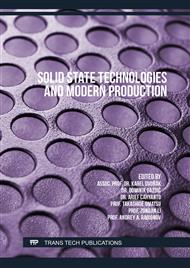[1]
Y. Alfawaz, Zirconia crown as single unit tooth restoration: A literature review, Journal of Contemporary Dental Practice, 17(5), (2016) 418–422.
DOI: 10.5005/jp-journals-10024-1865
Google Scholar
[2]
B. Stawarczyk, A. Emslander, M. Roos, B. Sener, F. Noack, C. Keul, Zirconia ceramics, their contrast ratio and grain size depending on sintering parameters, Dental Materials Journal, 33(5), (2014) 591–598.
DOI: 10.4012/dmj.2014-056
Google Scholar
[3]
S. Saridag, O. Tak, G. Alniacik, Basic properties and types of zirconia: An overview, World Journal of Stomatology, 2(3), (2013) 40-47.
DOI: 10.5321/wjs.v2.i3.40
Google Scholar
[4]
T. Kosmač, A. Kocjan, Ageing of dental zirconia ceramics, Journal of the European Ceramic Society, 32 (11), (2012) 2613–2622.
DOI: 10.1016/j.jeurceramsoc.2012.02.024
Google Scholar
[5]
I. Denry, J. R. Kelly, State of the art of zirconia for dental applications, Dental Materials, 24(3), (2008) 299–307.
DOI: 10.1016/j.dental.2007.05.007
Google Scholar
[6]
C. Gautam, J. Joyner, A. Gautam, J. Rao, R. Vajtai, Zirconia based dental ceramic: structure, mechanical properties, biocompatibility and applications, Dalton Transactions, 45(48), (2016) 19194-19215.
DOI: 10.1039/c6dt03484e
Google Scholar
[7]
S. K. Durrani, J. Akhtar, M. Ahmad, M. A. Hussain, Synthesis and characterization of low density calcia stabilized zirconia ceramic for high temperature furnace application, Materials Chemistry and Physics, 100 (2–3), (2006) 324–328.
DOI: 10.1016/j.matchemphys.2006.01.010
Google Scholar
[8]
S. M. Dizaj, M. Barzegar-Jalali, M. Hossein Zarrintan, K. Adibkia, F. Lotfipour, Calcium carbonate nanoparticles; Potential in bone and tooth disorders, Pharmaceutical Sciences, 20(4), (2015) 175–182.
DOI: 10.1517/17425247.2015.1049530
Google Scholar
[9]
A. S. Al-Chalabi, M. Chakmakchi, A. A. Taqa, Effect of Nano Calcium Oxide Intra Canal Medicaments on the Sealing Integrity of Root Canal Treated Teeth, EC Dental Science, 7 (2019) 1369–1377.
Google Scholar
[10]
A. I. Hussein, A. N. C. Mat, N. A. A. Abd Wahab, I. Ab. Rahman, A. Husein, Z. Ab-Ghani, Synthesis and properties of novel calcia-stabilized zirconia (Ca-SZ) with nano calcium oxide derived from cockle shells and commercial source for dental application, Applied Sciences (Switzerland), 10(17). (2020) 1-13.
DOI: 10.3390/app10175751
Google Scholar
[11]
A. Gionea, E. Andronescu, G. Voicu, C. Bleotu, & V. A. Surdu, Influence of hot isostatic pressing on ZrO2–CaO dental ceramics properties, International Journal of Pharmaceutics, 510(2), (2016) 439–448.
DOI: 10.1016/j.ijpharm.2015.10.044
Google Scholar
[12]
N. A. A. Ghani, Z. Ab-Ghani, Y. M. B. Ismail, K. A. Shariff, A. N. C. Mat, Z. Ariffin, T. Liszen, A. F. M. Noor, Non-aqueous sol-gel derived calcia partially stabilized zirconia: synthesis and characterization, Malaysia Journal of Microscopy, 16(1), (2020) 67-74.
Google Scholar
[13]
M. M. Uz, A. K. Aydinoğlu, A. B. H. Yoruç, Effects of binder and compression strength on molding parameters of dental ceramic blocks, Ceramics International, 46(8), (2020) 10186-10193.
DOI: 10.1016/j.ceramint.2020.01.010
Google Scholar
[14]
L. Jiang, Y. Liao, Q. Wan, W. Li, Effects of sintering temperature and particle size on translucency of zirconium dioxide dental ceramic, Journal of Materials Science: Materials in Medicine, 22(11), (2011) 2429-2435.
DOI: 10.1007/s10856-011-4438-9
Google Scholar
[15]
L. Gharibshahi, E. Saion, E. Gharibshahi, A. H. Shaari, K. A. Matori, Structural and optical properties of ag nanoparticles synthesized by thermal treatment method. Materials, 10(4), (2017) 402.
DOI: 10.3390/ma10040402
Google Scholar
[16]
R. Yogamalar, S. Anitha, R. Srinivasan, A. Vinu, K. Ariga, A. C. Bose, An investigation on co-precipitation derived ZnO nanospheres, Journal of Nanoscience and Nanotechnology, 9(10), (2009) 5966–5972.
DOI: 10.1166/jnn.2009.1289
Google Scholar
[17]
F. Chen, J. M. Wu, H. Q. Wu, Y. Chen, C. H. Li, Y. S. Shi, Microstructure and mechanical properties of 3Y-TZP dental ceramics fabricated by selective laser sintering combined with cold isostatic pressing, International Journal of Lightweight Materials and Manufacture, 1(4), (2018) 239–245.
DOI: 10.1016/j.ijlmm.2018.09.002
Google Scholar
[18]
J. Fan, T. Lin, F. Hu, Y. Yu, M. Ibrahim, R. Zheng, J. Ma, Effect of sintering temperature on microstructure and mechanical properties of zirconia-toughened alumina machinable dental ceramics, Ceramics International, 43(4), (2017) 3647–3653.
DOI: 10.1016/j.ceramint.2016.11.204
Google Scholar
[19]
I. Yakub, J. Du, & W. O. Soboyejo, Mechanical properties, modelling and design of porous clay ceramics, Materials Science and Engineering A, 558, (2012) 21–29.
DOI: 10.1016/j.msea.2012.07.038
Google Scholar
[20]
K. J. Chun, J. Y. Lee, Comparative study of mechanical properties of dental restorative materials and dental hard tissues in compressive loads, Journal of Dental Biomechanics, 5 (2014) 0–5.
DOI: 10.1177/1758736014555246
Google Scholar
[21]
L. Zhao, S. Yao, J. Du, Modification effect of nanometre zirconia on Ca-PSZ Ceramics, Materials Science Forum, 953 (2019) 59-64.
DOI: 10.4028/www.scientific.net/msf.953.59
Google Scholar



